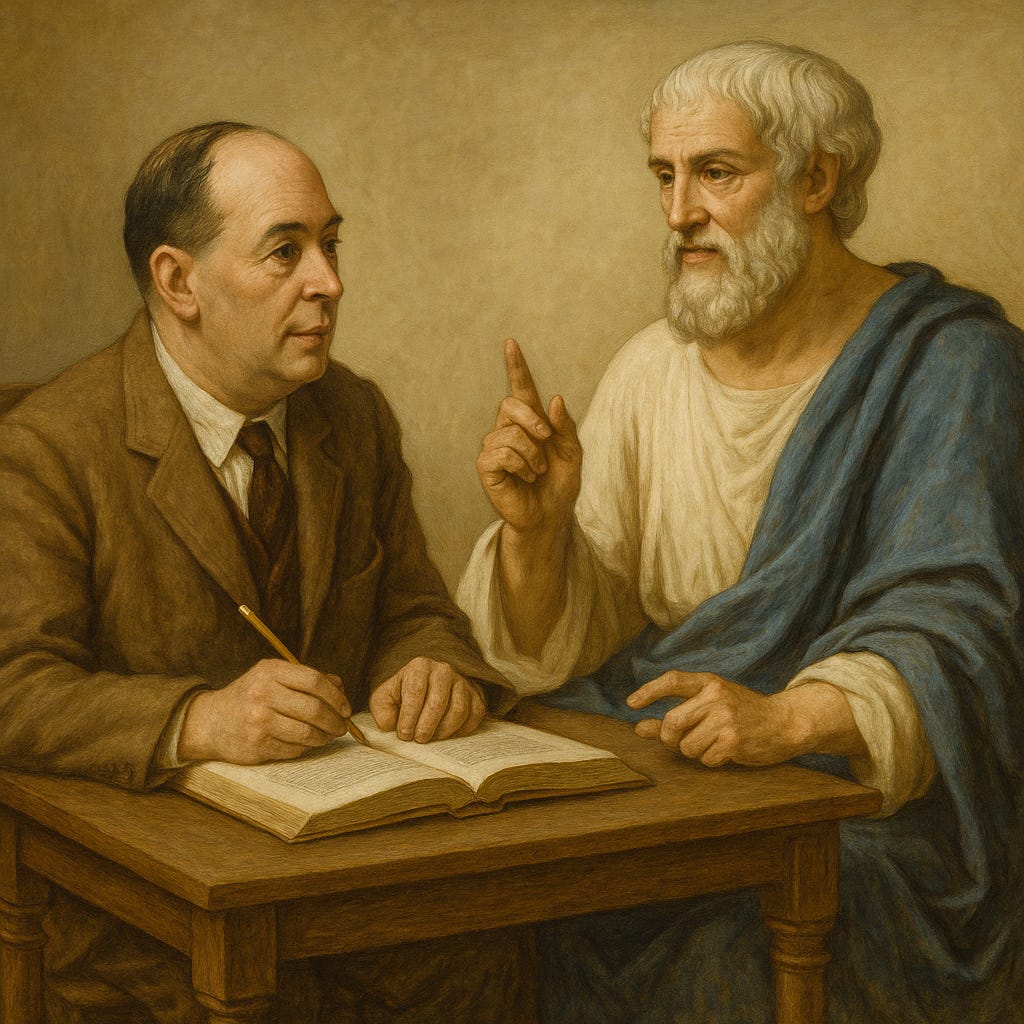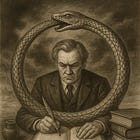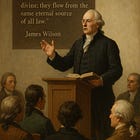C. S. Lewis, like Aristotle, grounded virtue in the reality of being and fixed human nature. By contrast, Alasdair MacIntyre invoked the language of Aristotle but severed it from metaphysical realism, reducing virtue to communal construct. One safeguards liberty; the other dissolves it.
C. S. Lewis wrote The Abolition of Man in 1943 as a prophetic defence of education and culture against the rising tide of relativism and scientism. His primary concern was that the denial of objective value; the reduction of truth to preference and of morality to subjective feeling, would dissolve the very understanding and recognition of man as a rational and moral agent. For Lewis, the reality of what he called ‘the Tao’ was not a convention but the created given order of being. It was the metaphysical ground of Natural Law, the perennial standard without which liberty, justice and civic life collapse into manipulation and power. In his words, “the effort to refute it and raise a new system of value is self-contradictory; you can step outside the Tao only by stepping into the void.”¹
In Lewis’s novel That Hideous Strength, the ‘void’ is the ultimate state of spiritual and moral disorientation, incoherence and disintegration; the nihilism that consumed the Deputy Director, John Wither. Wither’s journey to the void is an allegory for Lewis’s critique of metaphysical inversion and Theory of Ideas philosophies, as explained in his non-fiction work The Abolition of Man (itself predicated upon his essay The Poison Of Subjectivism). Lewis argues that when reason and morality are at root neoplatonic, hermetic and constructivist (unmoored from the Aristotle/Aquinas foundation of natural law in relation to eternal law) they descend into a state of nihilism and hubristic, post human tyranny - The Abolition Of Man. John Wither’s descent into the void is a progressive, cumulative process. His path began with a youthful, intellectual aesthetic distaste for anything he considered crude or vulgar, just as Kant had sneered at Common Sense Realism, in the tradition of all sophists seeking to advance their own systems of ‘sophistication’.
For John Wither (and so many ‘well educated’ intellectuals) this ingesting of and assenting to sophistries evolved into an intellectual refusal of anything not himself. Lewis describes how Wither passed “from Hegel into Hume, thence through Pragmatism, and thence through logical Positivism and out at last into the complete void“. By refusing to believe in any objective truth, Wither essentially willed himself into a state of unreality. As Lewis writes, “He had willed with his whole heart that there should be no reality and no truth and now even the imminence of his own ruin could not wake him“.
Scottish Common Sense Realists Henry Holmes, James Beattie and Thomas Reid warned of the grave consequences of falling for sophistry would be two centuries centuries earlier but the pride of man is rather ‘deaf and blind’ to heeding this, especially in the face of grants, subsidies, scholarships, publications and promotions to be secured, all of which reward and advance the sophistry. Heeding the warnings of the metaphysical realists has been career suicide for a very long time and this is why we are here, in the position we’re in.
Alasdair MacIntyre’s After Virtue (1981) appeared nearly four decades later, hailed as a revival of virtue ethics after the long dominance of utilitarianism, liberal individualism and positivist social science. Like Lewis, MacIntyre diagnosed modern culture as fragmented, emotivist and incapable of sustaining genuine moral discourse. He invoked a rhetoric of virtue, tradition and community that resonated with readers disenchanted by liberal abstractions. Yet, beneath the surface, MacIntyre’s project diverged radically from Lewis’s metaphysical realism. MacIntyre did not affirm the Tao as objective order; he located the meaning of virtue within historically contingent communities. Rationality itself, he argued, was ‘tradition-constituted’². His turn to Catholicism in later life gave his work a kind of ‘Thomistic’ gloss, but the structure of his argument remained communitarian and historicist, not realist. This divergence of telos; objective participation in being for Lewis, communitarian coherence for MacIntyre, matters profoundly for civic formation. Lewis was defending the conditions under which law, governance and education could be anchored in the fixed nature of man. MacIntyre was repositioning the discourse of virtue to serve a historicist and communitarian framework. Where Lewis’s metaphysical realism safeguarded liberty, MacIntyre’s communitarianism subtly undermined it by displacing universals with tradition-dependent narratives.
Lewis’s Realist Telos
Lewis’s insistence on objective value was not merely academic. He understood that the denial of essences and final causes was not only a philosophical error but a political and educational catastrophe. Without recognition of man’s fixed nature, education ceases to form rational agents; it becomes psychological conditioning.³ Without objective moral law, governance becomes management of populations. Without Natural Law, rights become permissions and liberty dissolves into license or control. This was the warning embedded in his image of ‘men without chests’ - beings trained (through Wundt/Thorndike/Dewey/Bernays Leipzig Lab/Tavistock/Columbia/SRI/Esalen etc) to feel only impulses while stripped of the rational moral center that enables self-governance. Reverse engineering ‘Horses & Dogs’ at scale, precisely as the Founders had warned NOT to do if the People were to be capable of ‘Keeping’ their Republic.
The telos Lewis defended was therefore participatory and civic; to preserve man’s capacity for virtue by affirming the reality (and intelligibility) of objective value. In the context of modern education, it meant safeguarding curricula from relativist indoctrination. In the context of law, it meant affirming the natural rights articulated in the American Declaration of Independence as rooted in universal human nature. For governance, it meant resisting technocratic management that reduces man to biological function and behavioural data. Lewis’s metaphysics of virtue was therefore inseparable from the defence of constitutional self-government.
MacIntyre’s Communitarian Turn: Advancing The Dialectic
Alasdair MacIntyre began his intellectual career in Marxist and socialist circles and this historicist orientation never left him. In After Virtue, he sought to explain the fragmentation of modern moral discourse by appealing to the collapse of coherent traditions. His solution was not to re-anchor civic life in the metaphysical realism of Natural Law, but to re-embed rationality and virtue in particular communities. Virtue, in this framework, is intelligible only within practices defined by social traditions.⁴
This is where MacIntyre’s project, while borrowing Lewis’s diagnosis of emotivism, departs entirely from Lewis’s remedy. Lewis defended man’s access to objective reality; MacIntyre subordinated moral reasoning to tradition-bound communities. The result is a communitarian ethic that sounds Aristotelian in rhetoric but is Hegelian in structure and function (in operation) because it locates order not in being but in narrative. As one critic has noted, “MacIntyre’s Aristotelianism is an Aristotelianism without metaphysics.”⁵
Aristotelianism Without Metaphysics: The Rhetoric of Virtue as Veilcraft
When that critic (John Haldane) made the potent observation that MacIntyre’s revival of Aristotle is “an Aristotelianism without metaphysics,” he named a tactic that has become one of the most effective tools of modern intellectual veilcraft. Aristotle, in his own system, is inseparable from metaphysical realism; every being has a fixed nature (ousia), intelligible through reason, ordered toward a telos and participating in the structure of reality itself. To speak of Aristotelian ethics without this metaphysical framework is to hollow out its foundation. Virtue then becomes a sociological construct, a set of practices stabilized by community, rather than the flourishing of man’s nature as it exists in reality.
This is precisely what MacIntyre does in After Virtue. He invokes Aristotle rhetorically (virtue, practice, telos) but detaches these from their ontological ground. In the past few years the number of public intellectuals who don’t do this has been exceptionally rare. Sadly and gravely, it is the default for pretty much all intellectual and cultural debate and content of any kind in the Media, with ‘consumers’ of this media eagerly yet passively consuming these prepackaged, attractively presented substitutes for real learning. In MacIntyre’s framework (as with constructivists more generally), telos is not intrinsic to being but tradition-dependent; the coherence of the community defines the shape of the good. The effect is to smuggle in constructivism under the language of virtue, making readers believe they are recovering Aristotelian moral realism when in fact they are being re-situated in historicism. It is an especially potent and highly effective political tool of influence. This tactic has now spread widely among contemporary intellectuals positing ‘solutions’ to civic and cultural decay and destruction. The many well financed, publicized public figures and Influencers offering the cant of ordered liberty and return to order. Ordo ab Chaos. It is not confined to MacIntyre but has become a default mode of academic and public discourse. For more on that term ‘discourse’ and its purposed intent, please see here:
https://unconstrainedanalytics.org/?s=Discourse
The Strategic Disjunction: Veilcraft
The rhetorical sleight of hand here can be named as veilcraft. Veilcraft is the strategic disjunction between (a) the rhetorical claim being made, (b) the surface interpretation most readers will take away, and (c) the deeper metaphysical operation actually at work. In this case, the rhetorical claim is that modern emotivism must be countered by a return to virtue. The surface interpretation is that MacIntyre is continuing Lewis’s defense of objective morality and extending Thomist realism into modernity. But the metaphysical operation is the opposite; virtue is stripped from its grounding in being and relocated into communal narratives. Veilcraft works precisely because the surface rhetoric borrows credibility from Lewis, while the deeper operation negates the very metaphysics Lewis sought to defend.
American Constitutional Consequences
The divergence between Lewis and MacIntyre becomes most visible when viewed with relation to American constitutional order. The Declaration of Independence grounds liberty in the ‘Laws of Nature and of Nature’s God’, asserting that all men are ‘endowed by their Creator with certain unalienable Rights’. This is a realist understanding; rights are rooted in human nature, which is fixed, intelligible and universal. James Wilson, one of the Constitution’s framers, affirmed this explicitly; “The law of nature and the law of revelation are both divine; they flow, though in different channels, from the same adorable source.”⁶ The Constitution, in turn, is structured to safeguard this ontological reality by vesting sovereignty in the people, not in the state. Lewis’s metaphysics undergirds this framework. Liberty and rights are grounded in the nature of man, not in state permission or communal consensus. Education must form citizens capable of discerning truth; law must protect rights as ontological givens; governance must remain limited, accountable and ordered toward justice.
MacIntyre’s communitarianism undercuts this foundation. By making virtue dependent on traditions, he dissolves the universality of natural rights. Law becomes an artifact of community rather than recognition of being. Education becomes the enculturation of narratives not the formation of rational agents. Constructivist education pedagogy changed formation in (a field/discipline) to cultural experience of behavioural custom, stripped of intelligibility and the requisite literacy to understand and articulate it. In this way, governance becomes the management of cosmetic traditions and customs (aesthetics only), rather than the safeguarding of liberty. In short, communitarianism replaces popular sovereignty rooted in Natural Law with communal sovereignty defined by historical coherence. This is not a defence of the American republic but a philosophical accommodation of its negation through balkanization and/or dissolution.
Contemporary Examples
Yoram Hazony frequently invokes Aristotle and the language of virtue in Conservatism: A Rediscovery, but he does so in the service of a nationalist-traditionalist framework. The good, in his scheme, is not the universal flourishing of man’s fixed nature, but the stability of inherited traditions. ‘Aristotle’ becomes a rhetorical shield for communal loyalty, not metaphysical realism.
Patrick Deneen in Why Liberalism Failed draws on Aristotelian language of virtue and telos but embeds it within a communitarian critique of liberalism that ultimately reduces virtue to political structures. By displacing metaphysics with sociology, his ‘Aristotle’ is again not the realist defender of natural law, but a prop for a narrative of ‘communal restoration’.
Jordan Peterson references Aristotle’s notions of order and virtue but collapses them into Jungian symbolic archetypes and evolutionary psychology. In his framework, ‘essence’ is erroneously reinterpreted as adaptive behaviour, not metaphysical reality. His ‘Aristotle’ is a pragmatic archetype, a psychological myth, not the realists metaphysics of being.
John Vervaeke explicitly positions himself as retrieving ‘Aristotelian’ notions of virtue and wisdom in his Awakening from the Meaning Crisis lectures, but he does so through cognitive science and Neoplatonic-Buddhist synthesis. Aristotle’s realism is stripped out and replaced with process philosophy, emergence and relevance ‘realization’ (subjectivism and constructivism which both root to neoplatonism and hermetic principles). Virtue here becomes cognitive attunement to patterns of meaning, not participation in the fixed telos of being. Virtue can be taken to any simulacra this way.
Jordan Hall (formerly Greenhall) deploys Aristotelian language of potentiality, telos and virtue within the Game B discourse, but detaches it from essences. His framework is radically constructivist and systems-theoretic; telos becomes an emergent property of networks, not an ontological given. ‘Aristotle’ is invoked rhetorically to give gravitas, but the metaphysical ground is inverted into processual futurism. This has immense operational value to the architects and engineers of the New Socio-Economic Order coming online as ‘Communitarianism’ which has been written about by various whistle blowers for a number of decades. The outworking of global governance networks and soft totalitarianism behaviourist affordances and conditions of access - supplanting inalienable rights.
Civic Dangers of the Hollow Aristotle
Why does this matter civically? Because once virtue is detached from being, it can no longer ground liberty. Virtue becomes an instrument of social cohesion, deployed by the state, the community, or cultural elites to manage populations. Law becomes an artifact of communal will, not a recognition of the order of being. Governance becomes the enforcement of narratives, not the protection of natural rights. In this frame, ‘virtue’ is not a shield for liberty but a tool for control. Readers who do not see this disjunction fall prey to veilcraft. They hear Aristotelian language and assume constitutional metaphysics is being defended, when in fact it is being dissolved. They confuse rhetoric with ontology and essence with behaviour. In doing so they consent to frameworks that negate the very liberties Aristotle’s realism and the American Constitution were designed to safeguard. This is precisely what the ‘Virtue or Liberty’ Dialectics traffic in which is the Media content put out by Public Intellectuals and well funded promoted Think Tank operatives almost everyone is currently lauding and applauding. The sheep dogs corral from all sides as the sheep of all faiths and none are herded into the One pen - Communitarianism. Your ‘belief’, your emotional investment in and intellectual assent to the dialectical deception that it’s ‘Liberty or Virtue’ has been a well strategized, highly funded media and institutional operation from the outset, promoting influence operators and public intellectuals to outsource your thinking to. Really - what will it take for you to stop doing this and to learn for yourselves the very foundations of both virtue and liberty, their shared root and its codification within the Founding Documents of the only country on earth to have made the commitment to set that apart - as sacred - for all men, for all time.
🇺🇸Left column
The real Aristotelian inheritance; metaphysical realism, fixed essences, natural law and liberty grounded in being.
🐍Middle column
How contemporary figures invoke Aristotle rhetorically but sever him from metaphysics, turning virtue into a construct.
☠️Right column
The civic outcomes of this veilcraft; loss of inalienable rights, subordination of liberty to state, tribe, narrative, or system.
Why It Matters
The American Founders drew explicitly on the left column. The Declaration’s self-evident truths and Wilson’s lectures on Natural Law assume essences, telos and universals. If the public locks onto the middle column; rhetorical Aristotle without metaphysics, they unknowingly embrace frameworks that undo the civic fabric of the Republic. Virtue language then becomes the velvet glove for technocratic or communitarian control. These civic consequences of the divergence between Lewis and MacIntyre are stark. If Lewis’s vision had been followed, education would remain oriented toward the formation of rational agents capable of discerning truth. Law would remain anchored in Natural Law and universal rights and governance would remain accountable to the people’s sovereign participation in an order of being. By contrast, MacIntyre’s communitarian facilitates moral relativism institutionalized at the level of community. Education becomes enculturation into communal narratives. Law becomes a negotiation of tradition-dependent norms. Governance becomes management of traditions rather than recognition of universal rights. Liberty in this frame is always subordinate to the coherence of the community; self-governance dissolves into communal conformity.
The telos of Lewis and MacIntyre could not be more different, despite shared rhetoric. Lewis sought to preserve man as a rational, moral agent grounded in objective being; MacIntyre sought to reconstitute moral reasoning as tradition-bound practice. One safeguarded Natural Law and constitutional liberty; the other subordinated them to community and history. That this appropriation has gone largely unnoticed (???) is itself evidence of how deeply veilcraft has shaped modern awareness and discussion. To recover liberty today requires not simply affirming ‘virtue’ but recognizing, articulating and acknowledging its metaphysical ground in being. Anything less is to accept, however unintentionally, ‘virtue’ without being - the captivity of Communitarianism.
1. C. S. Lewis, The Abolition of Man (New York: HarperOne, 2001 [1943]), 43–44.
2. Alasdair MacIntyre, Whose Justice? Which Rationality? (Notre Dame: University of Notre Dame Press, 1988), x.
3. Lewis, The Abolition of Man, 25–26.
4. Alasdair MacIntyre, After Virtue: A Study in Moral Theory, 3rd ed. (Notre Dame: University of Notre Dame Press, 2007), 187–203.
5. John Haldane, “MacIntyre’s Thomist Revival: What Next?” in Alasdair MacIntyre: Contemporary Philosophy in Focus, ed. Mark C. Murphy (Cambridge: Cambridge University Press, 2003), 101.
6. James Wilson, Lectures on Law, 1790–1791, in Collected Works of James Wilson, ed. Kermit L. Hall and Mark David Hall (Indianapolis: Liberty Fund, 2007), 1030.








Okay, just the substack and FB operations for me. Your writing and the topics are like portals for me so much appreciated. Have shared a few on FB hoping for some discussion
Thank you. Are you on Fakebook?